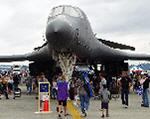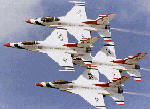
|
Description
| Notes: DH-4 (U.S. Version of British D.H.4) with modified fuel system, 110 gallon main tank | ||
| Manufacturer: | De Havilland | |
| Base model: | DH-4 | |
| Designation: | DH-4 | |
| Version: | A | |
| Designation System: | Various US Military | |
| Designation Period: | 1909-1919 | |
| Basic role: | Undesignated Aircraft | |
Specifications
| Not Yet Available |
Recent comments by our visitors
| Guy E. Franklin Deastville, AL | The versatile de Havilland DH-4 played many roles in both military and civilian capacities. In addition to its bombing activities in World War I, the DH-4 was an observation and photoreconnaissance aircraft. Between the Wars, one of its most important tasks was aerial mapping for the Army Air Service.
The DH-4 was introduced in England in 1917. Because of the War, time for new aircraft development was limited, so an American version of the already existing aircraft was produced in this country. More than 4000 DH-4s equipped with the American Liberty Engine were manufactured in the U.S. by 1919. The Air and Space Museum's aircraft is the first of these to be built. After the War, modifications were made to correct design and safety flaws and the "Liberty Planes", as the DH-4s were called, were used in many fields, including forest patrols, geologic reconnaissance, and aerial photgraphy. The Army Air Service was called upon to supply the Army Corps of Engineers and the Geological Survey with aerial photos for mapping and stereo viewing. The DH-4 was the most suitable and, because of its great mumbers, the most available plane for the job. It was used as the standard airplane for the purpose for 10 years. Aerial cameras in the DH-4 could be hand-held or mounted either inside or outside the rear cockpit. 09/28/2006 @ 09:27 [ref: 14312] |
| Guy E. Franklin Deastville, AL | The versatile de Havilland DH-4 played many roles in both military and civilian capacities. In addition to its bombing activities in World War I, the DH-4 was an observation and photoreconnaissance aircraft. Between the Wars, one of its most important tasks was aerial mapping for the Army Air Service.
The DH-4 was introduced in England in 1917. Because of the War, time for new aircraft development was limited, so an American version of the already existing aircraft was produced in this country. More than 4000 DH-4s equipped with the American Liberty Engine were manufactured in the U.S. by 1919. The Air and Space Museum's aircraft is the first of these to be built. After the War, modifications were made to correct design and safety flaws and the "Liberty Planes", as the DH-4s were called, were used in many fields, including forest patrols, geologic reconnaissance, and aerial photgraphy. The Army Air Service was called upon to supply the Army Corps of Engineers and the Geological Survey with aerial photos for mapping and stereo viewing. The DH-4 was the most suitable and, because of its great mumbers, the most available plane for the job. It was used as the standard airplane for the purpose for 10 years. Aerial cameras in the DH-4 could be hand-held or mounted either inside or outside the rear cockpit. The aircraft on display contains a Kodak L-4 camera positioned within the cockpit to take photographs through a small window in the floor. 09/28/2006 @ 09:26 [ref: 14311] |
| Howard G Walker Montgomery, AL | Top Speed: 128 MPH
Cruise: 90 MPH Ceiling: 19,600 ft Engine: Liberty V-12, 421 HP Introduction to the United States Air Force B Chance Saltzman, CAPT, USAF Air University Press Maxwell AF Base 1999 02/03/2001 @ 16:58 [ref: 1531] |
Recent photos uploaded by our visitors





